Film & Movies
What was the original screenplay for Disney’s “Haunted Mansion” movie like?
Thanks to loyal JHM reader, MrTheFrog, here's the first detailed description of Walt Disney Pictures' much anticipated November 2003 release. Just be warned, foolish mortals … there be spoilers ahead!
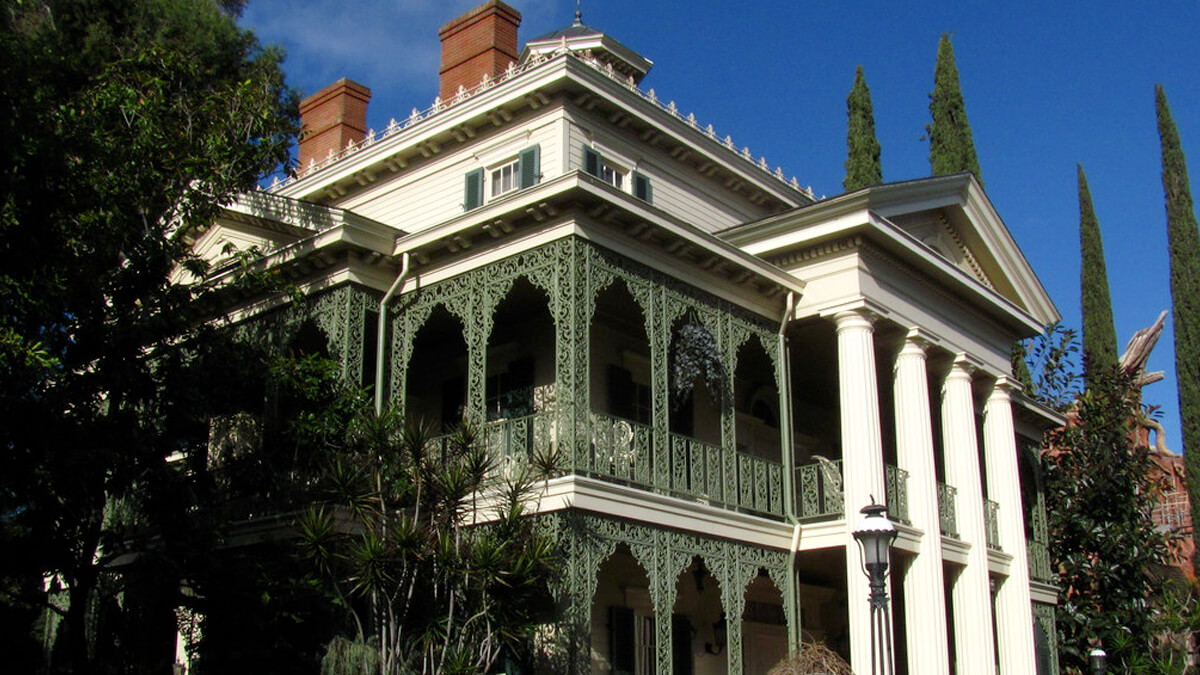
Hey gang! Jim Hill here. You know, one of the things that I really love about the Internet is that — every so often — something truly wonderful pops up in your e-mail. Three weeks ago, it was all that “Project Gemini” stuff. And just this past weekend, I received a wonderful gift from a MrTheFrog. It seems that a friend of his works in the industry. Which is how MrTheFrog managed to get ahold of a copy of the script of Walt Disney Pictures’ much anticipated November 2003 release, “The Haunted Mansion.” Which he then — quite kindly, I might add — offered to describe this screenplay in great detail for JHM readers.
I know that film fans have expressed much concern about this project. The Disneyana community seems particularly concerned about Disney’s decision to cast Eddie (“The Adventures of Pluto Nash”) Murphy as the lead in this picture. And … let’s be honest here … that somewhat silly, rather cheesy looking “Haunted Mansion” teaser trailer that the Mouse released to theaters last month didn’t exactly help the situation.
Still, it’s hard to really judge a motion picture based on the few tidbits that leak out while the project’s still in production. That’s why MrTheFrog’s upcoming script description is such a gift. For the first time anywhere, you’re going to get to read a really detailed description of the characters you’ll encounter in this movie. Plus you’ll get definitive information about what parts of the much beloved theme park attraction turn up in the “Haunted Mansion” movie.
A word of caution: there are spoilers ahead! If — come November — you really want to walk into your local multiplex without knowing in advance every twist and turn of this film’s plot (Well, maybe not every twist. Because he really doesn’t want to ruin the entire “Haunted Mansion” movie for everyone, MrTheFrog has held back a few crucial plot points. For which we should be grateful … I guess), now might be a good time to stop reading this particular column.
Also, the copy of the “Haunted Mansion” screenplay that MrTheFrog is reviewing today is a fairly early draft. One from ‘way back in January of 2002. Given that production didn’t actually begin on this picture ’til January 7, 2003, that means that the Mouse (not to mention “Haunted Mansion” director Rob Minkoff) had plenty of time to massage this script.
Which may not have actually been a good thing. Why? Because as you read this review, you’ll find that MrTheFrog really liked the original version of the “Haunted Mansion” screenplay. He goes out of his way to praise David Berenbaum’s efforts to stay true to the film’s source material (I.E. the “Haunted Mansion” theme park attraction). How — by building on real pieces of the ride’s mythology (MrTheFrog repeatedly has kind words for all the research that Mr. Berenbaum put into this project) — David managed to produce a very entertaining screenplay. A solid script that could serve as a pretty good blueprint for a fairly entertaining film.
But then … well, this is where MrTheFrog’s upcoming column gets kind of depressing. You see, this is the section where he addresses all the stories that he’s heard to date about the version of Disney’s “Haunted Mansion” movie that’s being shot right now. And that — if we’re to go by Jennifer Tilly’s recent comments to “TV Guide” — it’s pretty obvious that Mr. Berenbaum’s carefully researched, respectful-of-the-original-attraction screenplay has been joked up and hoked up.
So I guess what I’m saying is that the script review that follows is kind of a mixed bag. You’ll hear all about this truly cool “Haunted Mansion” screenplay that Disney evidently lost confidence in. Which is why (I guess) the studio felt it was necessary to punch this script up by adding kooky krazy touches like a mouthy Madam Leota who gets carried around like a bowling ball.
Hearing about stuff like this (as well as Tilly’s claim that the Imagineers are making plans to change the classic “Haunted Mansion” theme park attractions so that it better reflects the forthcoming film) doesn’t exactly fill my heart with joy. But then I remember that WDFA vets like Rob Minkoff and Don Hahn are riding herd on this project. So I hold out hope that all these “improvements” may actually improve the picture.
Anyway … if you’re a “foolish mortal” and want to know quite a bit about Disney’s “Haunted Mansion” movie months before you head out to the multiplex, read on. If you’re prefer to be surprised when you stop by your local cinema in November, stop reading now.
Okay. You can’t say that I didn’t warn you …
Hi everyone, I’m a longtime reader of Jim Hill’s work, and about six months ago I moved out to L.A. to work. A few days ago, I was lucky enough to snag a copy of the script for “Disney’s The Haunted Mansion.” It’s an early version, dated January 11, 2002. I’ll get to the description in a second, but first, let me start off by saying that I had much fear about this project for a number of reasons…
1. “The Country Bears”: Disney’s “re-imagining” of the classic theme park characters left a lot to be desired. It left out some of the most popular bears, instead deciding to tell the story of some of the background characters. Big mistake. (BTW, a little known fact: Did you know that Big Al sang a version of the ever popular “Blood on the Saddle” as an opening act for the Bears’ big finale? Supposedly it was filmed, but didn’t make it into the final cut.) Though the bears themselves were beautifully created by Jim Henson’s Creature Shop, all the technology in the world wasn’t gonna save this movie. A badly written script is a badly written script.
2. Disney’s writers-in-residence program: It’s this program that spawned “The Country Bears”, and where David Berenbaum wrote “The Haunted Mansion” script. From what I understand, the writers are paid a salary to come up with scripts based on the Disney attractions. I’ve been told, that since they already work for the mouse and are receiving a salary, that the company doesn’t have to buy the scripts from them, and as a result get off dirt cheap. If you ask me, that’s not much motivation to rack your brain, trying to turn a 50 year old ride into a cohesive story.
3. Eddie Murphy: The moment I heard that he was starring in this film, I considered it dead in the water. Not that he’s a bad actor. He’s actually one of my favorite actor/comedians out there. But was he really an appropriate star for a film based on Disneyland’s most popular attraction?
4. Jennifer Tilly as Madame Leota: This really scared me, and not in a good way … I mean come on.
Anyway, I sat down to read this early version of the script expecting to be scared, horrified, even terrified by how they were going to destroy a classic. You’ll be happy to know that I was very pleasantly surprised.
Here’s the set-up:
The film begins in the New Orleans town of “Liberty”. In a pristine old mansion, a soon-to-be bride, sits in her room, penning a letter to her one true love. Her dress sits on the bed beside her. As she finishes, she wipes away the tears, rises, sprinkles some powder into a glass of wine, and drinks from it. A moment later, the nobleman she was to marry, rushes into the room to find her dead on the floor. Jump ahead to the present.
Eddie Murphy plays Jim Evers, a workaholic attorney. Obsessed with getting ahead, he has very little time for his wife Sara, or his two children Megan and Michael. He is in line for a huge promotion, but in order to seal the deal, he has to meet with the head of his company. And one thing the big boss is very fond of is the idea of “family.” So in the interest of making a good impression, Jim drags his family, kicking and screaming, to meet him, in his big house, behind a big iron gate, on top of a big hill. And what is his name? Master Edward Gracey.
Once inside, the members of the Evers family are trapped in the house, and separated from one another. Through a series of events Jim is lead to a séance room where he meets Madame Leota, a cryptic fortune teller whose head is inside a crystal ball, played by Jennifer Tilly. She tells him the tragic tale of the bride, and explains to him that he and his family are doomed to forever join the 999 happy haunts, unless they can set the bride free by the 13th hour.
Along the way, they meet an interesting (and familiar) cast of characters, including:
– An old caretaker (played by Don Knotts), and his skin-n-bones dog. – Phineas Pock: a plump ghost with a top hat – Ezra: a tall thin skeletal ghost with a long coat and derby – Gus: a short ghost with a long bushy beard, and a ball and chain around his leg. – And of course, Master Gracey.
The writer David Berenbaum did a wonderful job with this story, leaving no stone unturned. From the floating candelabra, to the portraits with the wandering eyes, this is a writer who did his homework, and he has an absolute masterpiece to show for it. This is THE definitive Haunted Mansion movie. I’ve been a Disney fan for 28 years now, as well as a former cast member. And I’ve been to both WDW and Disneyland hundreds of times, so needless to say, I’m very critical. But all that kept running through my head as I read this was “Wow. WOW!” As it stands now, it’s completely 100% faithful to the ride. If this is done right, it could possibly be the best live-action Disney film since Walt’s time. I kid you not. This has the potential to be a huge, HUGE hit for them.
I think what I liked so much is, this is not a kiddy movie. There are lots of parts that are very intense, and disturbing. I have a hard time believing they’ll get a PG rating out of it (probably PG-13). Eddie Murphy is perfectly cast in this role. His comic relief is much needed for the dark grim story that they tell. And Don Knotts … need I say more? Now Jennifer Tilly as Madame Leota … well, if done like the script, she’ll have a relatively small, but important role. And she’ll be fine, as long as she doesn’t joke it up …
… which leads us to the second part of this story. If you remember, back at the beginning of this article, I stated that the script I read, is dated January 11, 2002. That’s right, 2002, over a year ago. And as expected some things are going to change. How much will change? I don’t know. But let’s look at a few quotes from some people involved with the film:
In a recent TV Guide article, Jennifer Tilly had the following to say: “When you go into the ride [at Disney], there’s a gypsy fortune teller’s head in a crystal ball, saying, ‘Go back, Go back!’ You know, Madame Leota. That’s gonna be me! I’m Eddie Murphy’s sidekick in the movie. He carries my head around, and I get bossy with him. I have lots of hair, I’m a smart ass, and I’m very cryptic. I know all, I see all … if the movie’s really successful, Disney’s gonna revamp the ride and I’ll be the head in the ball at the beginning of it! They’re gonna totally update it.”
Well I can tell you that in the version I read, she is far from a sidekick. At no time does she get “bossy,” or is she a “smart ass,” and not once does Eddie carry her head around with him. His son does for one scene, but never Eddie. So if this is true, then some things have changed. They may have toned things down to make it more family friendly.
In another interview, Director Rob Minkoff said “It will actually have more of an inflection on the ride than the ride will have an inflection on the movie” and later added “There will be special effects but no character animation so there will be a lot of ghost effects but no character ghosts, not like Casper. I think there was some thought originally that there might be.”
Now this kinda scares me simply because, the script I read, and the ride are so similar that it would make his first statement absolutely false … unless a lot has been changed. And regarding the “no character ghosts”, I’m not quite sure how to take that. My assumption is that he means the ghosts will be played by humans with enhanced make-up and special effects, rather than being animated. Though looking at the Internet Movie Database, I only see “Little Ghost” listed (possibly Gus), as well as “Queen Ghost”. Which brings up another question: Who the heck is ‘Queen Ghost’? There was no Queen Ghost in the script. Is it a fancy name for the ghost of the bride? Is it a new character completely?
And why do all the descriptions of the film say: “When a workaholic visits a haunted house with his family during a job interview, he meets a ghost that teaches him a lesson about the importance of the family that he has neglected.” The key word there is “a ghost”. There was no definitive ghost in this script. There were many, each with their own role to play. But there was not one, that was really any more special than the other, unless they’re talking about Madame Leota. So, again, characters may have been cut, things may have changed.
But on a more positive note, Marsha Thomason, who plays Eddie’s wife, said in a February 2003 interview “We’ve got the singing heads. We’ve got the whole mausoleum. We’ve got Madame Leota. Jennifer Tilly is playing Madame Leota. There’s a whole lot of the Disney ride in the movie. It’s fab!”
So who knows? The version I read didn’t have the singing busts, but they’d be a welcome addition. And according to her, it’s a lot like the ride. So I guess the only thing we could do is wait until November when it’s released. But in the meantime, let me leave you with this small excerpt from the script. The set-up is Eddie Murphy’s character, Jim Evers, is in an octagonal room, admiring the paintings on the wall:
“Jim walks to leave, but can’t find the door. He turns confused … Jim looks around in confusion. Jim turns to the window … or where the window used to be. No window. He turns to leave, but now there’s no door. He looks around, but there’s definitely no door. No windows and no doors–“
Indeed.
Film & Movies
How Disney’s “Bambi” led to the creation of Smokey Bear

When people talk about Disney’s “Bambi,” the scene that they typically cite as being the one from this 1942 film which then scarred them for life is – of course – the moment in this movie where Bambi’s mother gets shot by hunters.
Which is kind of ironic. Given that – if you watch this animated feature today – you’ll see that a lot of this ruined-my-childhood scene actually happens off-camera. I mean, you hear the rifle shot that takes down Bambi’s Mom. But you don’t actually see that Mama Deer get clipped.
Now for the scariest part of that movie that you actually see on-camera … Hands down, that has to be the forest fire sequence in “Bambi.” As the grown-up Bambi & his bride, Faline, desperately race through those woods, trying to find a path to safety as literally everything around them is ablaze … That sequence is literally nightmare fuel.
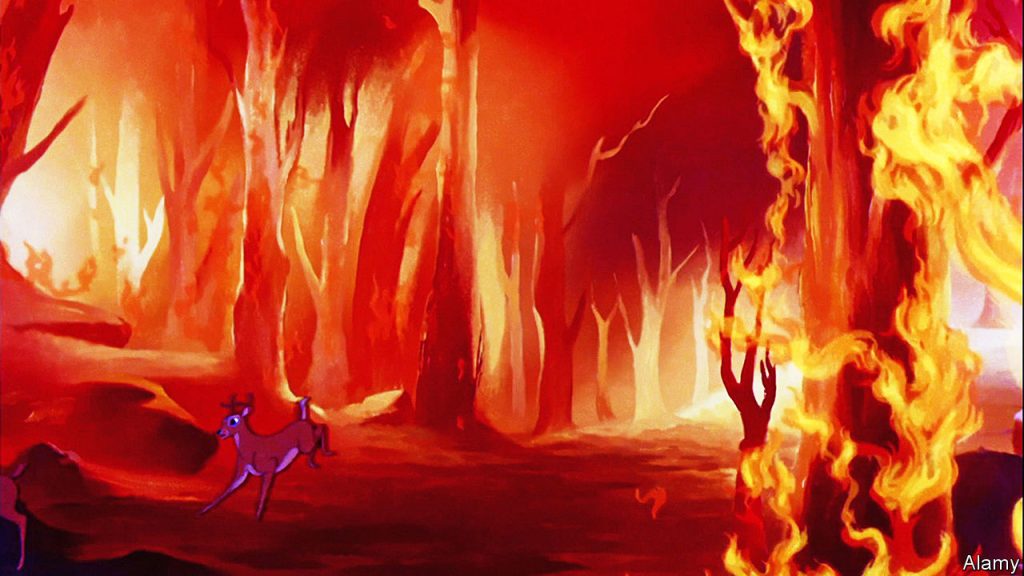
Mind you, the artists at Walt Disney Animation Studios had lots of inspiration for the forest fire sequence in “Bambi.” You see, in a typical year, the United States experiences – due to either natural phenomenon like lightning strikes or human carelessness – 100 forest fires. Whereas in 1940 (i.e., the year that Disney Studios began working in earnest of a movie version of Felix Salten’s best-selling movie), America found itself battling a record 360 forest fires.
Which greatly concerned the U.S. Forest Service. But not for the reason you might think.
Protecting the Forest for World War II
I mean, yes. Sure. Officials over in the Agricultural Department (That’s the arm of the U.S. government that manages the Forest Service) were obviously concerned about the impact that this record number of forest fires in 1940 had had on citizens. Not to mention all of the wildlife habitat that was now lost.
But to be honest, what really concerned government officials was those hundreds of thousands of acres of raw timber that had been consumed by these blazes. You see, by 1940, the world was on the cusp of the next world war. A conflict that the U.S. would inevitably be pulled into. And all that now-lost timber? It could have been used to fuel the U.S. war machine.
So with this in mind (and U.S. government officials now seeing an urgent need to preserve & protect this precious resource) … Which is why – in 1942 (just a few months after the Japanese bombed Pearl Harbor) – the U.S. Forest Service rolls out its first-ever forest fire prevention program.
Which – given that this was the early days of World War II – the slogan that the U.S. Forest Service initially chose for its forest fire prevention program is very in that era’s we’re-all-in-this-together / so-let’s-do-what-we-can-to-help-America’s war-effort esthetic – made a direct appeal to all those folks who were taking part in scrap metal drives: “Forest Defense is National Defense.”

And the poster that the U.S. Forest Service had created to support this campaign? … Well, it was well-meaning as well. It was done in the WPA style and showed men out in the forest, wielding shovels to ditch a ditch. They were trying to construct a fire break, which would then supposedly slow the forest fire that was directly behind them.
But the downside was … That “Forest Defense is National Defense” slogan – along with that poster which the U.S. Forest Service had created to support their new forest fire prevention program didn’t exactly capture America’s attention.
I mean, it was the War Years after all. A lot was going in the country at that time. But long story short: the U.S. Forest Service’s first attempt at launching a successful forest fire prevention program sank without a trace.
So what do you do in a situation like this? You regroup. You try something different.
Disney & Bambi to the Rescue
And within the U.S. government, the thinking now was “Well, what if we got a celebrity to serve as the spokesman for our new forest fire prevention program? Maybe that would then grab the public’s attention.”
The only problem was … Well, again, these are the War Years. And a lot of that era’s A-listers (people like Jimmy Stewart, Clark Gable, even Mel Brooks) had already enlisted. So there weren’t really a lot of big-name celebrities to choose from.
But then some enterprising official at the U.S. Forest Service came up with an interesting idea. He supposedly said “Hey, have you seen that new Disney movie? You know, the one with the deer? That movie has a forest fire in it. Maybe we should go talk with Walt Disney? Maybe he has some ideas about how we can better capture the public’s attention when it comes to our new forest fire prevention program?”
And it turns Walt did have an idea. Which was to use this government initiative as a way to cross-promote Disney Studio’s latest full-length animated feature, “Bambi.” Which been first released to theaters in August of 1942.
So Walt had artists at Disney Studio work up a poster that featured the grown-up versions of Bambi the Deer, Thumper the Rabbit & Flower the Skunk. As this trio stood in some tall grasses, they looked imploring out at whoever was standing in front of this poster. Above them was a piece of text that read “Please Mister, Don’t Be Careless.” And below these three cartoon characters was an additional line that read “Prevent Forest Fires. Greater Danger Than Ever!”
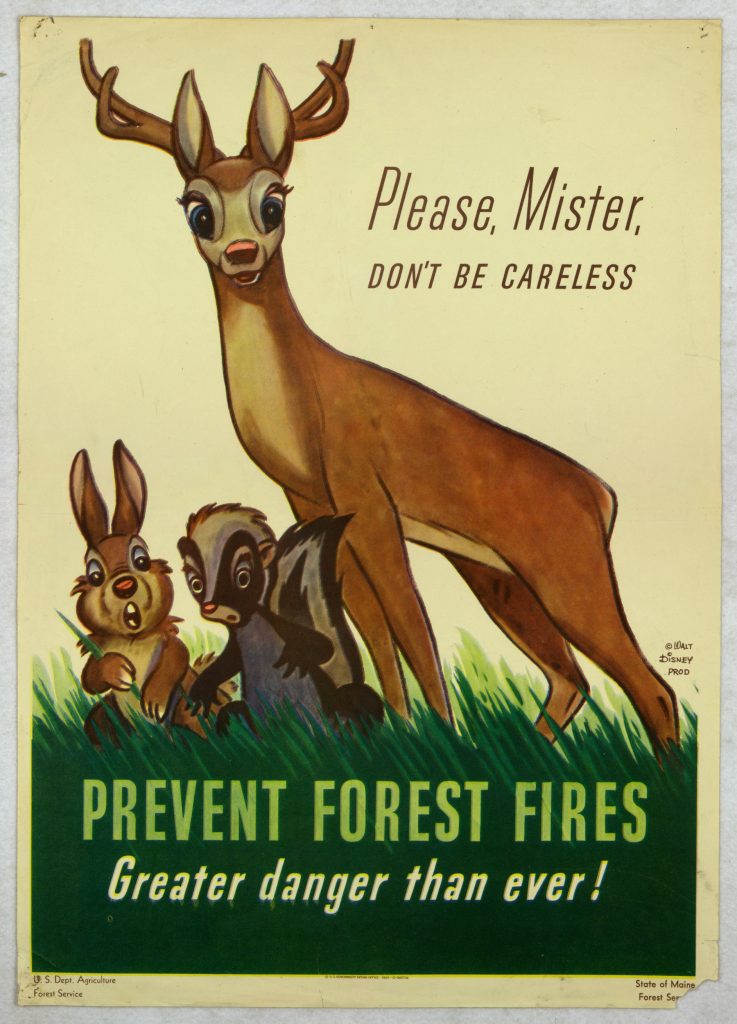
According to folks I’ve spoken with at Disney’s Corporate Archives, this “Bambi” -based promotional campaign for the U.S. Forest Service’s forest fire prevention campaign was a huge success. So much so that – as 1943 drew to a close – this division of the Department of Agriculture reportedly reached out to Walt to see if he’d be willing to let the U.S. Forest Service continue to use these cartoon characters to help raise the public’s awareness of fire safety.
Walt – for reasons known only to Mr. Disney – declined. Some have suggested that — because “Bambi” had actually lost money during its initial theatrical release in North America – that Walt was now looking to put that project behind him. And if there were posters plastered all over the place that then used the “Bambi” characters that then promoted the U.S.’s forest fire prevention efforts … Well, it would then be far harder for Mr. Disney to put this particular animated feature in the rear view mirror.
Introducing Smokey Bear
Long story short: Walt said “No” when it came to reusing the “Bambi” characters to promote the U.S. Forest Service’s forest fire prevention program. But given how successful the previous cartoon-based promotional campaign had been … Well, some enterprising employee at the Department of Agriculture reportedly said “Why don’t we come up with a cartoon character of our own?”
So – for the Summer of 1944 – the U.S. Forest Service (with the help of the Ad Council and the National Association of State Foresters) came up with a character to help promote the prevention of forest fires. And his name is Smokey Bear.
Now a lot of thought had gone into Smokey’s creation. Right from the get-go, it was decided that he would be an American black bear (NOT a brown bear or a grizzly). To make this character seem approachable, Smokey was outfitted with a ranger’s hat. He also wore a pair of blue jeans & carried a bucket.
As for his debut poster, Smokey was depicted as pouring water over a still-smoldering campfire. And below this cartoon character was printed Smokey’s initial catchphrase. Which was “Care will prevent 9 out of 10 forest fires!”
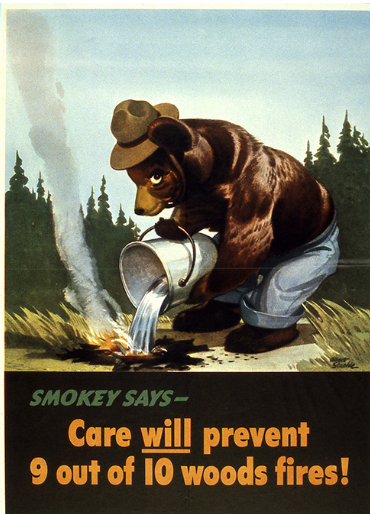
Which makes me think that this slogan was written by the very advertising executive who wrote “Four out of five dentists recommend sugarless gum for their patients who chew gum.”
Anyway … By the Summer of 1947, Smokey got a brand-new slogan. The one that he uses even today. Which is “Only YOU can prevent forest fires.”
The Real Smokey Bear
Now where this gets interesting is – in the Summer of 1950 – there was a terrible forest fire up in the Capitan Mountains of New Mexico. And over the course of this blaze, a bear cub climbed high up into a tree to try & escape those flames.
Firefighters were finally able to rescue that cub. But he was so badly injured in that fire that he was shipped off to the National Zoo in Washington, D.C. and nursed back to health. And since this bear really couldn’t be released back in the wild at this point, he was then put on exhibit.
And what does this bear’s keepers decide to call him? You guessed it: Smokey.
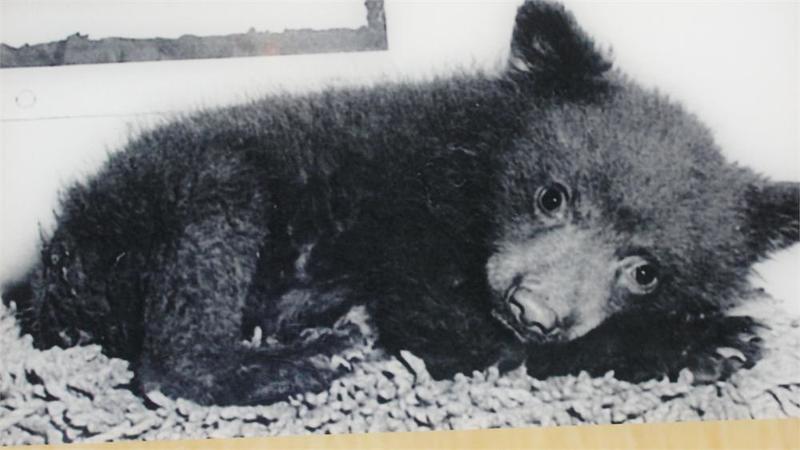
And due to all the news coverage that this orphaned bear got, he eventually became the living symbol of the U.S. Forest Service’s forest fire prevention program. Which then meant that this particular Smokey Bear got hit with a ton of fan mail. So much so that the National Zoo in Washington D.C. wound up with its own Zip Code.
“Smokey the Bear” Hit Song
And on the heels of a really-for-real Smokey Bear taking up residence in our nation’s capital, Steve Nelson & Jack Rollins decide to write a song that shined a spotlight on this fire-fightin’ bruin. Here’s the opening stanza:
With a ranger’s hat and shovel and a pair of dungarees,
You will find him in the forest always sniffin’ at the breeze,
People stop and pay attention when he tells them to beware
Because everybody knows that he’s the fire-preventin’ bear
Believe or not, even with lyrics like these, “Smokey the Bear” briefly topped the Country charts in the Summer of 1950. Thanks to a version of this song that was recorded by Gene Autry, the Singing Cowboy.
By the way, it was this song that started all of the confusion in regards to Smokey Bear’s now. You see, Nelson & Rollins – because they need the lyrics of their song to scan properly – opted to call this fire-fightin’-bruin Smokey THE Bear. Rather than Smokey Bear. Which has been this cartoon character’s official name since the U.S. Forest Service first introduced him back in 1944.
“The Ballad of Smokey the Bear”
Further complicating this issue was “The Ballad of Smokey the Bear,” which was a stop-motion animated special that debuted on NBC in late November of 1966. Produced by Rankin-Bass as a follow-up to their hugely popular “Rudolph the Red-Nosed Reindeer” (which premiered on the Peacock Network in December of 1964) … This hour-long TV show also put a “THE” in the middle of Smokey Bear’s name because the folks at Rankin-Bass thought his name sounded better that way.
And speaking of animation … Disney’s “Bambi” made a brief return to the promotional campaign for the U.S. Forest Service’s forest fire prevention program in the late 1980s. This was because the Company’s home entertainment division had decided to release this full-length animated feature on VHS.
What’s kind of interesting, though, is the language used on the “Bambi” poster is a wee different than the language that’s used on Smokey’s poster. It reads “Protect Our Forest Friends. Only You Can Prevent Wildfires.” NOT “Forest Fires.”
Anyway, that’s how Disney’s “Bambi” led to the creation of Smokey Bear. Thanks for bearin’ with me as I clawed my way through this grizzly tale.
Film & Movies
“Indiana Jones and the Search for Indiana Jones”
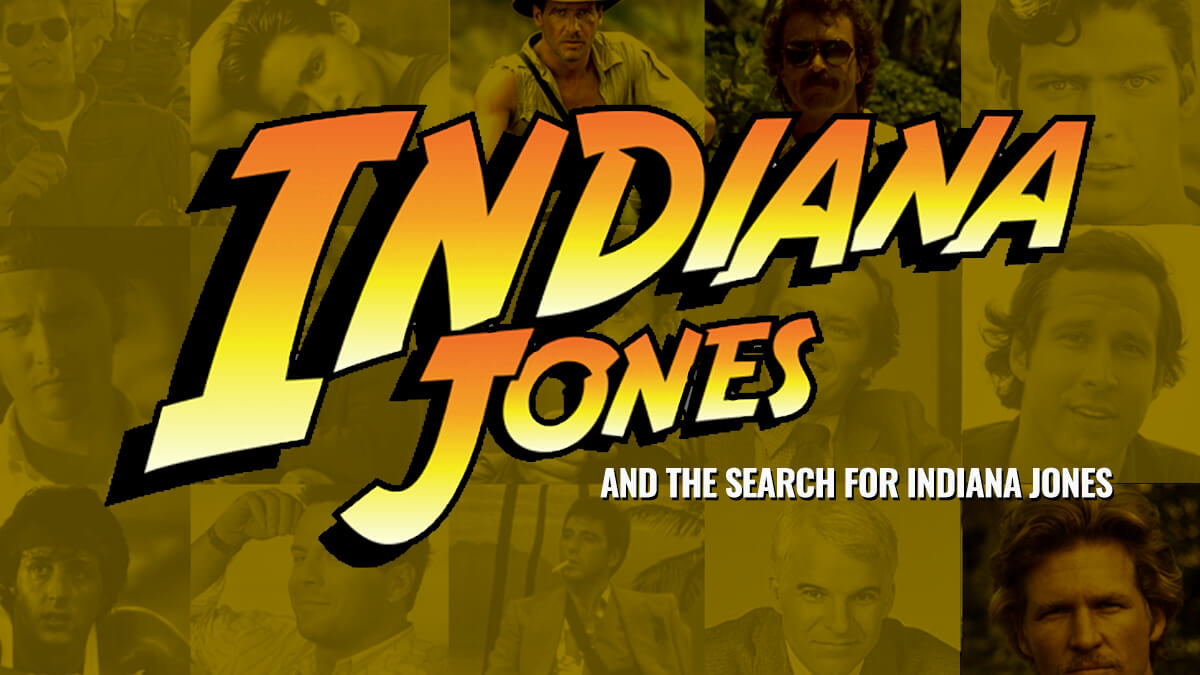
News came late last week that NBC was cancelling the “Magnum PI” remake. This series (which obviously took its inspiration from the Tom Selleck show that originally debuted on CBS back in December of 1980 and then went on run on that network for 8 seasons. With its final episode airing on May 8, 1988).
Anyway … Over 30 years later, CBS decided to remake “Magnum.” This version of the action drama debuted on September 24, 2018 and ran for four seasons before then being cancelled. NBC picked up the “Magnum” remake where it ran for one more season before word came down on June 23rd that this action drama was being cancelled yet again.
FYI: The second half of Season 5 of “Magnum” (10 episodes) has yet to air on NBC. It will be interesting to see when that final set of shows / the series finale gets scheduled.
This all comes to mind this week – out ahead of the theatrical release of “Indiana Jones and the Dial of Destiny” because … Well, if CBS execs had been a bit more flexible back in 1980, the star of the original version of “Magnum PI” (Tom Selleck) would have played the lead in “Raiders of the Lost Ark.” Which was released to theaters back on June 12, 1981.
That’s the part of the Indiana Jones story that the folks at Lucasfilm often opt to skim over.
That Harrison Ford wasn’t George Lucas’ first choice to play Doctor Jones.
Auditions for Indiana Jones – Harrison’s Not on the List
Mind you, Steven Spielberg – right from the get-go – had pushed for Ford to play this part. The way I hear it, Lucas showed Spielberg a work-in-progress cut of “The Empire Strikes Back.” And Steven was so taken with Harrison’s performance as Han Solo in that Irwin Kershner film that he immediately began pushing for Ford to be cast as Doctor Jones.
Whereas Mr. Lucas … I mean, it wasn’t that George had anything against Harrison. What with Ford’s performances first in “American Grafitti” and then in “A New Hope,” these two already had a comfortable working relationship.
But that said, Lucas was genuinely leery of … Well, the sort of creative collaboration that Martin Scorcese and Robert DeNiro. Where one actor & one director repeatedly worked together. To George’s way of thinking, that was a risky path to follow. Hitching your wagon to a single star.
Which is why – when auditions got underway for “Raiders of the Lost Ark” in 1979 — Mike Fenton basically brought in every big performer of that era to read for Dr. Jones except Harrison Ford. We’re talking:
- Steve Martin
- Chevy Chase
- Bill Murray
- Jack Nicholson
- Peter Coyote
- Nick Nolte
- Sam Elliot
- Tim Matheson
- and Harry Hamlin
Casting a Comedian for Indiana Jones
Please note that there are a lot of comedians on this list. That’s because – while “Raiders of the Lost Ark” was in development — Spielberg was directed his epic WWII comedy, “1941.” And for a while there, Steve & George were genuinely uncertain about whether the movie that they were about to make would be a sincere valentine to the movie serials of the 1930s & the 1940s or more of a spoof.
It’s worth noting here that three of the more ridiculous set pieces found in “Temple of Doom” …
- the shoot-out at Club Obi Wan in Shanghai
- Indy, Willie & Short Round surviving that plane crash by throwing an inflatable life raft out of the cargo hatch
- and that film’s mine cart chase (which was not only inspired by Disney theme park favorites the Matterhorn Bobsleds & Big Thunder Mountain Railroad but some of the sound effects that you hear in this portion of “Temple of Doom” were actually recorded after hours at Disneyland inside of these very same attractions)
… all originally supposed to be in “Raiders of the Lost Ark.” I’ve actually got a copy of the very first version of the screenplay that Lawrence Kasdan wrote for the first “Indy” movie where all three of these big action set pieces were supposed to be part of the story that “Raiders” told. And I have to tell you that this early iteration of the “Raiders” screenplay really does read more like a spoof of serials than a sincere, loving salute to this specific style of cinema.
Casting Indiana Jones – Jeff or Tom
Anyway … Back now to the casting of the male lead for “Raiders” … After seeing virtually every actor out in LA while looking for just the right performer to portray Indiana Jones, it all came down to two guys:
- Jeff Bridges
- and Tom Selleck
Jeff Bridges as Indiana Jones
Mike Fenton was heavily pushing for Jeff Bridges. Having already appeared with Clint Eastwood in 1974’s “Thunderbolt & Lightfoot” (Not to mention that “King Kong” remake from 1976), Bridges was a known quantity. But what Fenton liked especially liked about Bridges when it came to “Raiders” was … Well, at that time, Jeff was just coming off “Heaven’s Gate.”
Mind you, nowadays, because we’ve all now had the luxury of seeing the director’s cut of this Michael Cimino movie, we recognize “Heaven’s Gate” for the cinematic masterpiece that it is. But 40+ years ago, that honestly wasn’t the case. All audiences had to judge this movie by was the severely truncated version that United Artists sent out into theaters. Which – because “Heaven’s Gate” had cost $44 million to make and only sold $3.5 million of tickets – then became the textbook example of Hollywood excess.
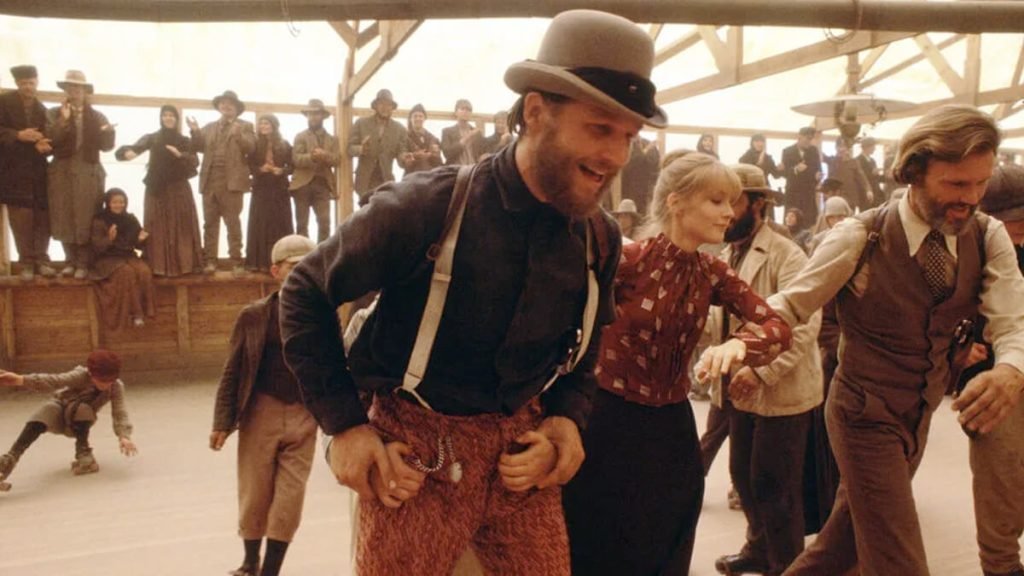
Long story short: Given that being associated with “Heaven’s Gate” had somewhat dinged Bridges’ reputation for being a marketable star (i.e., a performer that people would pay good money to see up on the big screen), Jeff was now looking to appear in something highly commercial. And the idea of playing the lead in a film directed by Steven Spielberg (the “Jaws” & “Close Encounter” guy) and produced by George Lucas (Mr. “Star Wars”) was very, very appealing at that time. Bridges was even willing to sign a contract with Spielberg & Lucas that would have then roped him into not only playing Indiana Jones in “Raider of the Lost Ark” but also to appear as this very same character in two yet-to-be-written sequels.
Better yet, because “Heaven’s Gate” had temporarily dimmed Bridges’ star status, Jeff was also willing to sign on to do the first “Indy” film for well below his usual quote. With the understanding that – should “Raiders of the Lost Ark” succeed at the box office – Bridges would then be paid far more to appear in this film’s two sequels.
That seemed like a very solid plan for “Raiders.” Landing a known movie star to play the lead in this action-adventure at a bargain price.
Ah, but standing in Mike Fenton’s way was Marcia Lucas.
Tom Selleck as Indiana Jones
Marcia Lucas, who had seen Tom Selleck’s audition for “Raiders” (And you can see it as well. Just go to Google and type in “Tom Selleck” and “Indiana Jones.” And if you dig around for a bit, you’ll then see a feature that Lucas & Spielberg shot for “Entertainment Tonight” back in 2008 [This story was done in support of the theatrical release of “Indiana Jones and the Kingdom of the Crystal Skull”]. And as part of this piece, George and Steve share Tom’s original audition for “Raiders.” And what’s genuinely fascinating about this footage is that Selleck’s scene partner is Sean Young. Who – at that time, anyway – was up for the role of Marion Ravenwood) and kept telling her husband, “You should cast this guy. He’s going to be a big star someday.”
And given that George was smart enough to regularly heed Marcia Lucas’ advice (She had made invaluable suggestions when it came to the editing of “American Graffiti” and the original “Star Wars.” Not to downplay George Lucas’ cinematic legacy, but Marcia Lucas was a world-class storyteller in and of her own right), Lucas then reached out to Spielberg and persuaded him that they should cast relative unknown Tom Selleck as Doctor Jones over the already well-known Jeff Bridges.
Now don’t feel too bad for Jeff Bridges. When he lost out on playing the lead in “Raiders of the Lost Ark,” Jeff then accepted a role in the very next, high profile, sure-to-be-commercial project that came along. Which turned out to be Disney’s very first “TRON” movie. Which was eventually released to theaters on July 9, 1982.
Back to Tom Selleck now … You have to remember that – back then – Selleck was the handsome guy who’d already shot pilots for six different shows that then hadn’t gone to series. Which was why Tom was stuck being the guest star on shows like “The Fall Guy” and “Taxi.” Whereas once word got out around town that Selleck was supposed to play the lead in a project that Spielberg was directed & Lucas was producing … Well, this is when CBS decided that they’d now take the most recent pilot that Tom had shot and then go to series with this show.
That program was – of course – the original “Magnum PI.” And it’s at this point where our story started to get complicated.
“Magnum PI” – Two Out of Three Say “Yes”
Okay. During the first season of a TV show, it’s traditionally the network – rather than the production company (which – in this case – was Glen A. Larson Productions. The company behind the original versions of “Battlestar Galactica” & “Knight Rider”) or the studio where this series is actually being shot (which – in this case – was Universal Television) that has all the power. And in this particular case, the network execs who were pulling all the strings behind-the-scenes worked for CBS.
And when it came to the first season of “Magnum PI,” CBS had a deal with Glen A. Larson Productions and Universal Television which stated that the talent which had been contracted to appear in this new action drama would then be available for the production of at least 13 episodes with an option to shoot an additional 9 episodes (This is known in the industry as the back nine. As in: the last nine holes of a golf course).
Anyway, if you take those initial 13 episodes and then tack on the back nine, you then get 22 episodes total. Which – back in the late 1970s / early 1980s, anyway – was what a full season of a network television show typically consisted of.
Anyway … The contract that Selleck had signed with Glen A. Larson Productions, Universal Television & CBS stated that he had to be available when production of Season One of “Magnum PI” began in March of 1980. More to the point, Tom also had to be available should CBS exercise its option to air 22 episodes of this new series on that television network over the course of “Magnum PI” ‘s first season.
Which then made things complicated for George Lucas & Steven Spielberg because … Well, in order for “Raiders of the Lost Ark” to make its June 12, 1981 release date, that then meant that production of the first “Indy” movie would have to get underway no later than June 23, 1980.
But here’s the thing: Production of Season One of “Magnum PI” was scheduled to run through the first week of July of that same year (1980). So in order for Tom Selleck to play Indiana Jones in “Raiders,” he was going to need to be wrapped on production of “Magnum PI” by June 22, 1980 at the absolute latest.
So Spielberg & Lucas went to Glen A. Larsons Productions and asked if Selleck could please be sprung from his “Magnum PI” contractual obligations by June 22nd. And they said “Yes.” Then Steven & George went to Universal Television and asked executives there for their help in clearing Tom’s schedule so that he’d then be available to start work on “Raiders.” And they say “Yes” as well.
Spielberg & Lucas now go to CBS. But instead of the quick “Yeses” that they got from officials at Glen A. Larson Productions and Universal Television, it takes those suits at the Tiffany Network weeks before they then decided to say “No, they couldn’t release Tom Selleck early to go work on ‘Raiders’ “ because …
I’ve never really been able to get a straight answer here as to why CBS execs dug in their heels here. Why they flat-out refused to release Selleck early from his “Magnum PI” contractual obligation and allow him to go shoot “Raiders.”
Payback from “The Star Wars Holiday Special” Trash Talk
That said, it is worth noting that “The Star Wars Holiday Special” aired on CBS back in November of 1978. And given that – in the years that followed — Lucas wasn’t exactly shy when it came to saying how much he hated that two hour-long presentation (Or – for that matter – how George really regretted caving into the requests of CBS execs. Who had insisted that television stars long associated with the Tiffany Network – people like Art Carney, Harvey Korman & Bea Arthur – be given prominent guest starring roles in “The Star Wars Holiday Special”). And I’ve heard whispers over the years that CBS executives preventing Tom Selleck from appearing in “Raiders” could be interpreted as the Tiffany Network getting some payback for what George had said publicly about the “Star Wars Holiday Special.”
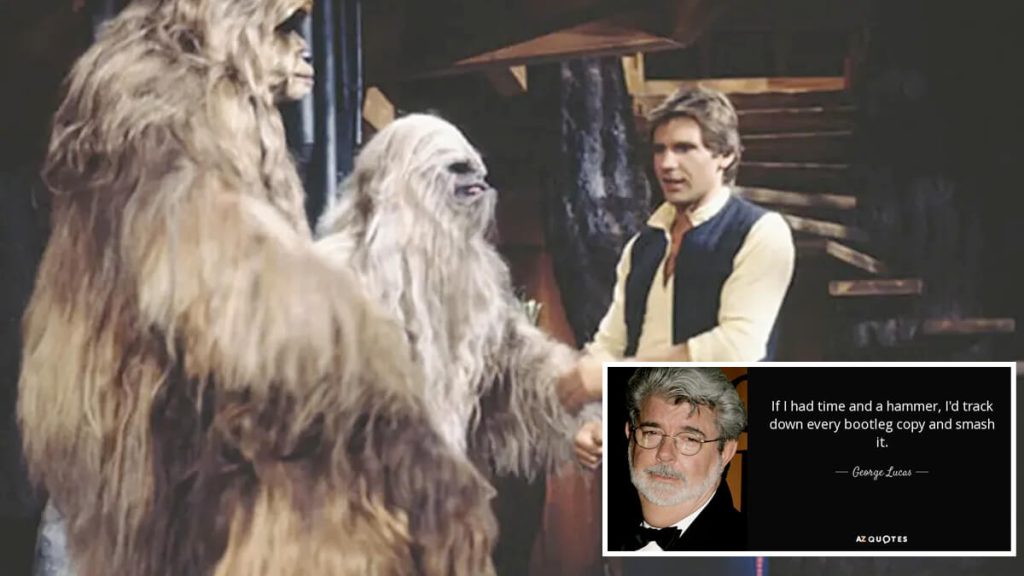
Harrison Ford Comes to Rescue “Indiana Jones”
Anyway … It’s now literally just weeks before production of “Raiders of the Lost Ark” is supposed to begin and Spielberg & Lucas have just learned that that they’ve lost their film’s star. CBS is flat-out refusing to release Tom Selleck early from his “Magnum PI” contractual obligation. So Steven & George now have to find someone else to play Indy … and fast.
The real irony here is … The American Federation of Television and Radio Artists would go on strike in the Summer of 1980. Which then shut prematurely shut down production of the first season of “Magnum PI.” (As a direct result, the first full season of this action drama to air on CBS only had 18 episodes, rather than the usual 22). And because this job action lasted ‘til October 23rd of that same year … Well, this meant that Tom Selleck would have actually been free to start shooting “Raiders of the Lost Ark” on June 23, 1980 because production of Season One of “Magnum PI” was already shut down by then due to that AFTRA strike.
But no one knew – in May of 1980, anyway – that this job action was going to happen in just a few weeks. All that Steven Spielberg & George Lucas knew was that they now needed a new lead actor for “Raiders.” And circling back on Jeff Bridges was no longer an option. As I mentioned earlier, Jeff had agreed to do “TRON” for Disney. And – in the interim – Bridges gone off to shoot “Cutter’s Way” for MGM / UA.
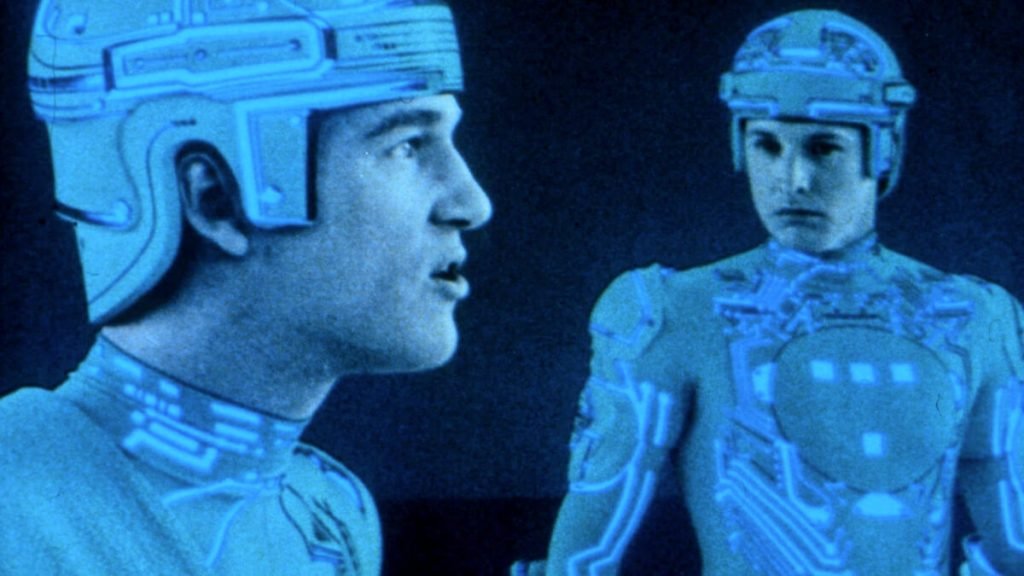
So this is where Harrison Ford enters the equation. As he recalls:
In May of 1980, I get a call from George Lucas. Who says ‘I’m messaging a script over to you this morning. As soon as it gets there, I need you to immediately read this script. Then – as soon as you’re done – I need you to call.
So the script arrives and it’s for ‘Raiders.’ I read it and it’s good. So I call George back and say ‘It’s good.’ And he then says ‘Would you be interested in playing Indy?’ I say that it looks like it would be a fun part to play.
George then says ‘ That’s great to hear. Because we start shooting in four weeks. Now I need you to meet with Steven Spielberg today and convince him that you’re the right guy to play Indy.’
Of course, given that Spielberg had been pushing for Ford to pay Indy ever since he had first seen that work-in-progress version of “The Empire Strikes Back” … Well, Harrison’s meeting with Steven was very, very short. And just a few weeks later, Spielberg, Lucas & Ford were all at the Port de la Pallice in La Rochelle. Where – on the very first day of shooting on “Raiders” (which – again – was June 23, 1980)– the scene that was shot was the one where that Nazi sub (the one that Indy had lashed himself to its periscope by using his bullwhip as a rope) was arriving at its secret base.
And all of this happened because Harrison immediately agreed to do “Raiders of the Lost Ark” when the part of Indy was first offered to him in mid-May of 1980.
Before “Star Wars” was “Star Wars”
So why such a quick yes? Well, you have to remember that “Empire Strikes Back” wouldn’t be released to theaters ‘til May 21, 1980. And no one knew at that time whether this sequel to the original “Star Wars” would do as well at the box office as “A New Hope” had back in 1977 (FYI: “Empire” would eventually sell over $500 million worth of tickets worldwide. Which is roughly two thirds of what the original “Star Wars” earned three years earlier).
More to the point, the four films that Harrison had shot right after “A New Hope” / prior to “Empire Strikes Back” (i.e., “Heroes” AND “Force 10 from Navarone” AND “Hanover Street” AND “The Frisco Kid”) had all under-performed at the box office. So to Ford’s way of thinking, taking on a role that Tom Selleck was no longer available to play – one that had the potential of spawning two sequels – seemed like a very smart thing to do. Especially after three years of cinematic stumbles.
By the way, whenever this topic ever comes up, Harrison Ford is very gracious. He always makes a point of saying that he’s grateful to have gotten this career opportunity. More to the point, that he still feels kind of bad that Tom Selleck never got the chance to play this part.
Tom Selleck After “Indiana Jones”
That said, we shouldn’t feel too bad for Tom Selleck. After all, the original “Magnum PI” proved to be a long running hit for CBS. And in an effort to smooth over any residual bad feelings that may have resulted from Tom being forced to give up “Raiders” back in May of 1980, Selleck was eventually allowed to create his own production company (i.e., T.W.S. Productions, Inc. As in Thomas William Selleck Productions). Which – after the fact – was then cut in on some of those “Magnum PI” -related revenue streams.
More to the point, while “Magnum PI” was on hiatus following its second year in production, Selleck flew off to Yugoslavia. Where he then shot his own Indiana Jones-esque film for theatrical release. Which was called “High Road to China” in the States, but – overseas – was promoted as “Raiders of the End of the World.”
FYI: Warner Bros. released “High Road to China” stateside 40 years ago this year. On March 18, 1983, to be exact. It didn’t do all that great at the box office. $28 million in ticket sales versus $15 million in production costs.
And over the years, there’s even been some talk of finding a way to maybe set things right here. By that I mean: Finally finding a way to officially fold Tom Selleck into the world of Indiana Jones.
Could Tom Selleck Work with Indiana Jones?
The way I hear it, between the time when “Indiana Jones and the Last Crusade” was theatrically released in May of 1989 and when “Indiana Jones and the Kingdom of the Crystal Skull” debuted in May of 2008, there were a number of ideas for Indiana Jones sequels tossed around. And from what I’ve been told, there was at least one treatment for a fourth Indiana Jones film written that proposed pairing up Harrison Ford & Tom Selleck. With the idea here being that Selleck was supposed to have played Ford’s brother.
Obviously that film was never made. And – no – I don’t know what state Indiana Jones’ brother was supposed to be named after.
This article is based on research for Looking at Lucasfilm “Episode 80”, published on June 29, 2023. Looking at Lucasfilm is part of the Jim Hill Media Podcast Network.
Film & Movies
Will “Metro” – that “Cars” Spin-Off Which Disney Developed – Ever Get Made?
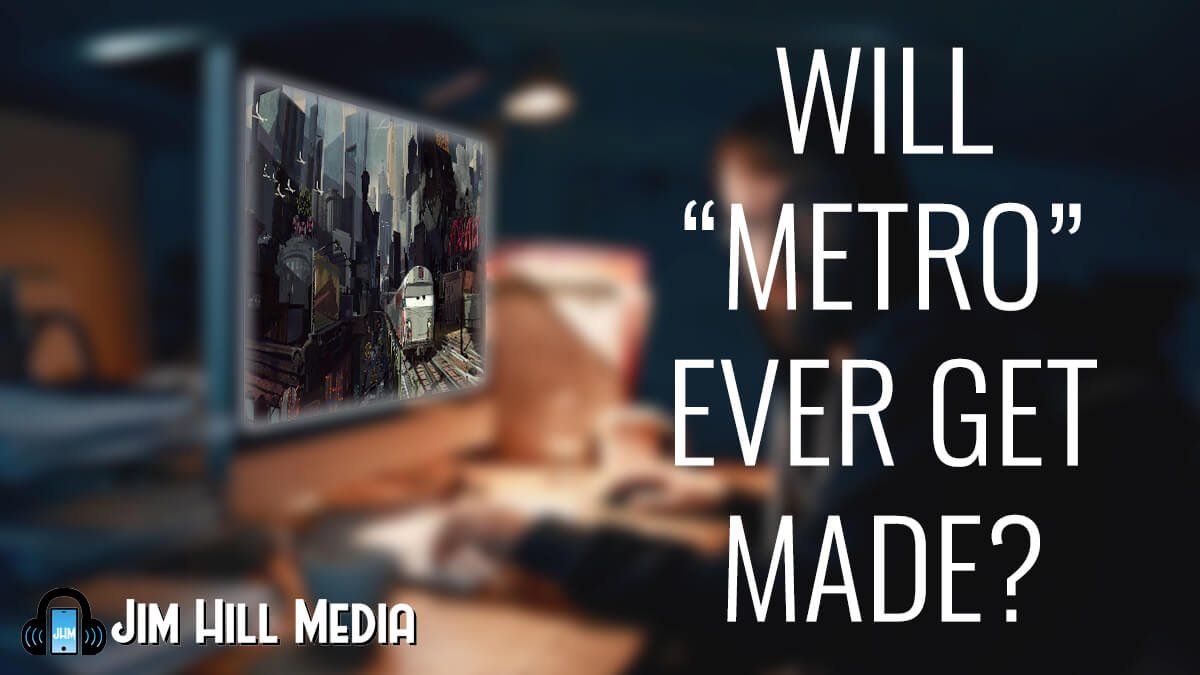
First came “Cars” in June of 2006.
This Pixar Animation Studios production did so well (Of all the high grossing films released that year, “Cars” was No. 2 at the box office. Only “Pirates of the Caribbean: Dead Man’s Chest” sold more tickets in 2006) that Disney execs asked John Lasseter to develop a sequel.
“Cars 2” came out in June of 2011 and also did quite well at the box office (It took the No. 7 slot in the Top-Ten-for-ticket-sales that year). Which is why Disney then asked Pixar to prep a follow-up film.
“Cars 3” would eventually arrive in theaters in June of 2017. But in the meantime, Disney & Pixar began exploring the idea of expanding this film franchise. Largely because the amount of money that the Mouse was making off of the sales of “Cars” -related merchandise was … To be blunt here, mind boggling.
Don’t believe me? Well, then consider this: In just the first five years that the “Cars” film franchise existed, global retail sales of merchandise related to these Pixar movies approached $10 billion. That’s billion with a “B.”
So is it any wonder that – while Pixar was still trying to get a handle on what “Cars 3” would actually be about – the Mouse (through its DisneyToon Studios arm. Which produced home premieres like those “TinkerBell” movies) began actively looking into ways to expand this lucrative franchise?
“Planes” – The First “Cars” Spin-Off
The first “Cars” spin-off to arrive in the marketplace was “Planes.” This Klay Hall film (which was set in “The World Above Cars”) was released theatrically in August of 2013, with the Blu-ray & DVD version of “Planes” hitting store shelves in November of that same year.
“Planes: Fire and Rescue” followed in the Summer of 2014. And while a “Planes 3” was definitely put in development (At the Disney Animation panel at the 2017 D23 Expo, John Lasseter not only shared a clip from this film. But he also revealed that this project – which, at that time, was entitled “Space” – was slated to be released theatrically in April of 2019) … This animated feature was abruptly cancelled when DisneyToon Studios was shuttered in June of 2018.
But wait. There’s more … In addition to the aborted “Planes 3,” Disney had other “Cars” spin-offs in the works. One was supposed to be built around boats. While yet another was supposed to have shined a spotlight on trucks.
“Metro” – The World Below Cars
And then there was “Metro.” Which was supposed to have been set in the inner city and focused on what went on in “The World Below Cars.” As in: Down in the subway system.
Just in the past week or so, a few pieces of concept art for “Metro” have surfaced online. Giving us all an intriguing look at what might have been. These preproduction paintings suggest that this “Cars” spin-off would be far grittier than … Say … the sort of adventures that Lightning McQueen & Mater would typically have out in Radiator Springs.
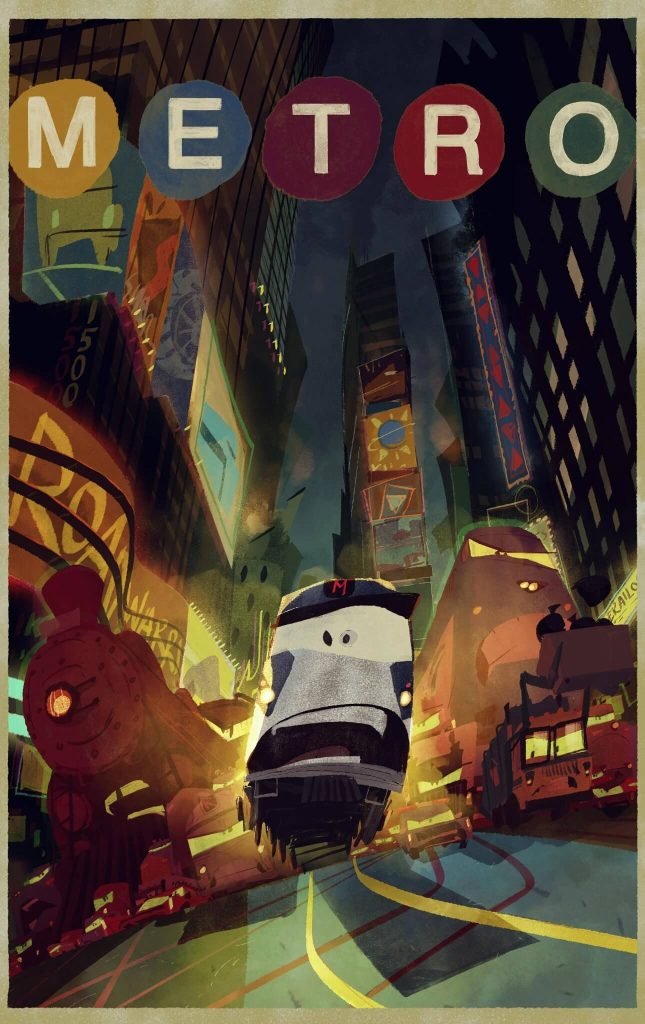
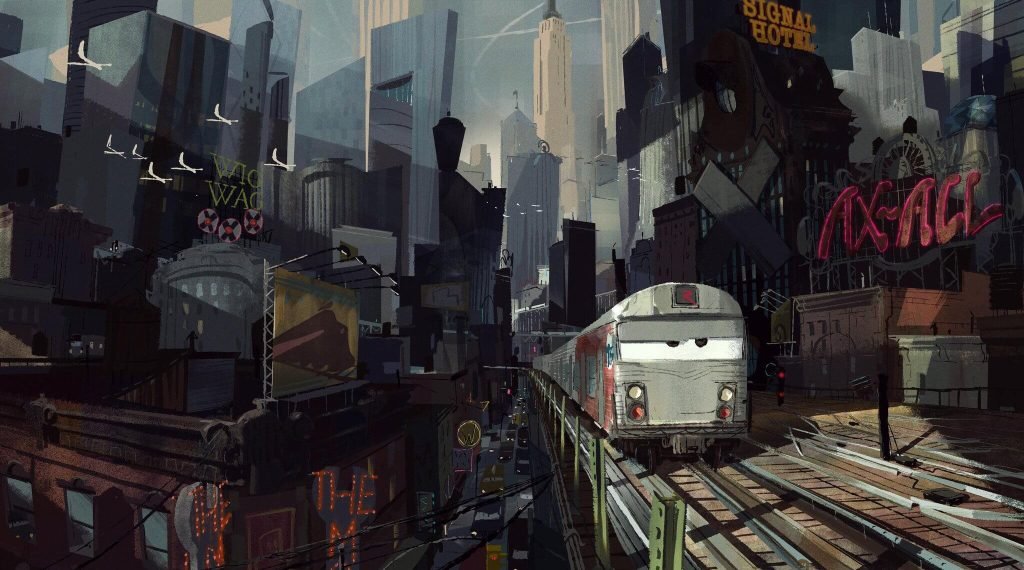
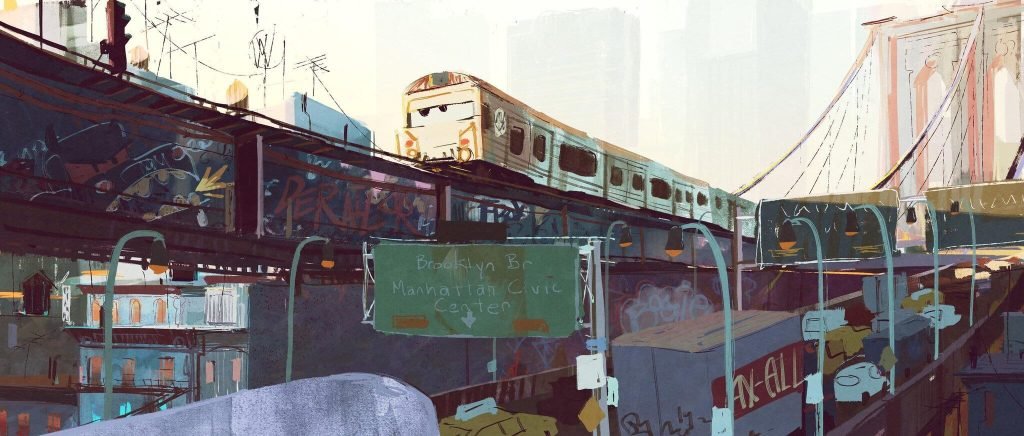
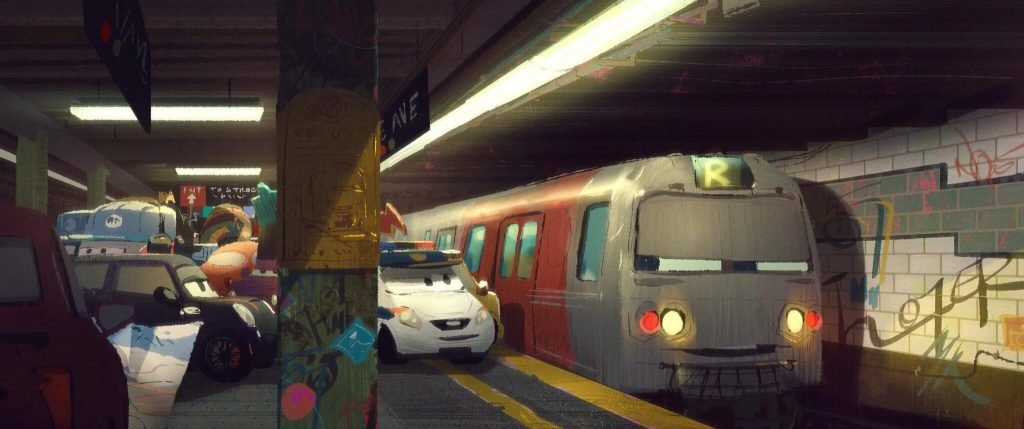
That said, it’s worth noting here that – just in the past year or so – we’ve seen Disney & Pixar attempt to expand the turf that these two characters could comfortably cover. Take – for example — “Cars on the Road,” that nine-part series which debuted on Disney+ back in September of last year. This collection of animated shorts literally sent Lightning McQueen & Mater off on a road trip.
So who knows?
Given that Bob Iger (at Disney’s quarterly earnings call held earlier this week) revealed that the Company now has sequels in the works for “Frozen,” “Toy Story,” and “Zootopia” … Well, is it really all that far-fetched to think that – at some point further on down the road – Disney & Pixar will put yet another sequel to “Cars” in the works?
One that might send Lightning McQueen & Mater off to explore the gritty inner-city world that we glimpsed in all that concept art for “Metro,” that never-produced “Cars” spin-off.
Time will tell.
-

 History11 months ago
History11 months ago31 Long-Gone Rides, Shows & Attractions at Disney-MGM (Hollywood Studios)
-

 News & Press Releases8 months ago
News & Press Releases8 months agoDisney Will Bring D23: The Ultimate Disney Fan Event to Anaheim, California in August 2024
-

 Theme Parks & Themed Entertainment12 months ago
Theme Parks & Themed Entertainment12 months agoFrom Aladdin to Indy – How Did We Get an Indiana Jones Stage Show at Disneyland?
-

 History4 months ago
History4 months agoFrom Birthday Wishes to Toontown Dreams: How Toontown Came to Be
-

 Theme Parks & Themed Entertainment12 months ago
Theme Parks & Themed Entertainment12 months agoHow Did We Get “Aladdin’s Oasis” at Disneyland?
-

 Film & Movies10 months ago
Film & Movies10 months ago“Indiana Jones and the Search for Indiana Jones”
-

 Theme Parks & Themed Entertainment10 months ago
Theme Parks & Themed Entertainment10 months agoWhen WDW Had a Racetrack – The Creation of the Walt Disney World Speedway
-

 History3 months ago
History3 months agoUnpacking the History of the Pixar Place Hotel









